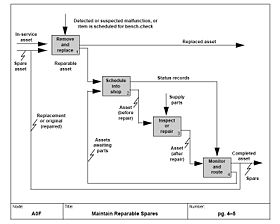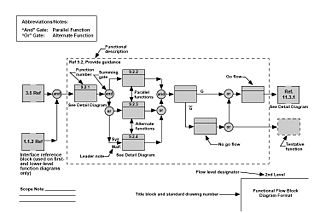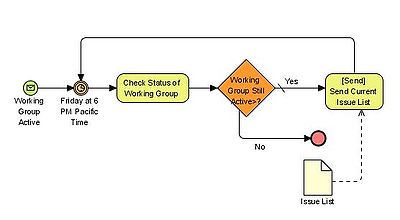
Systems modeling
Encyclopedia





Interdisciplinarity
Interdisciplinarity involves the combining of two or more academic fields into one single discipline. An interdisciplinary field crosses traditional boundaries between academic disciplines or schools of thought, as new needs and professions have emerged....
of the use of models to conceptualize and construct system
System
System is a set of interacting or interdependent components forming an integrated whole....
s in business
Business
A business is an organization engaged in the trade of goods, services, or both to consumers. Businesses are predominant in capitalist economies, where most of them are privately owned and administered to earn profit to increase the wealth of their owners. Businesses may also be not-for-profit...
and IT development
Information technology
Information technology is the acquisition, processing, storage and dissemination of vocal, pictorial, textual and numerical information by a microelectronics-based combination of computing and telecommunications...
.
A common type of systems modeling is function model
Function model
A function model or functional model in systems engineering and software engineering is a structured representation of the functions within the modeled system or subject area....
ling, with specific techniques such as the Functional Flow Block Diagram
Functional flow block diagram
A Functional Flow Block Diagram is a multi-tier, time-sequenced, step-by-step flow diagram of a system’s functional flow.The FFBD notation was developed in the 1950s, and is widely used in classical systems engineering...
and IDEF0
IDEF0
IDEF0 is a function modeling methodology for describing manufacturing functions, which offers a functional modeling language for the analysis, development, reengineering, and integration of information systems; business processes; or software engineering analysis.IDEF0 is part of the IDEF family...
. These models can be extended using functional decomposition
Functional decomposition
Functional decomposition refers broadly to the process of resolving a functional relationship into its constituent parts in such a way that the original function can be reconstructed from those parts by function composition...
, and can be linked to requirement
Requirement
In engineering, a requirement is a singular documented physical and functional need that a particular product or service must be or perform. It is most commonly used in a formal sense in systems engineering, software engineering, or enterprise engineering...
s models for further systems partition.
The Business Process Modeling Notation
Business Process Modeling Notation
Business Process Model and Notation is a graphical representation for specifying business processes in a business process model. It was previously known as Business Process Modeling Notation....
(BPMN), a graphical representation for specifying business processes in a workflow, can also be considered to be a systems modeling language.
Overview
In business and IT development the term "systems modeling" has multiple meaning. It can relate to:- the use of model to conceptualize and construct systems
- the interdisciplinary studyInterdisciplinarityInterdisciplinarity involves the combining of two or more academic fields into one single discipline. An interdisciplinary field crosses traditional boundaries between academic disciplines or schools of thought, as new needs and professions have emerged....
of the use of these models - the systems modeling, analysisSystems analysisSystems analysis is the study of sets of interacting entities, including computer systems analysis. This field is closely related to requirements analysis or operations research...
, and designSystems designSystems design is the process of defining the architecture, components, modules, interfaces, and data for a system to satisfy specified requirements. One could see it as the application of systems theory to product development...
efforts - the systems modeling and simulationSimulationSimulation is the imitation of some real thing available, state of affairs, or process. The act of simulating something generally entails representing certain key characteristics or behaviours of a selected physical or abstract system....
, such as system dynamicsSystem dynamicsSystem dynamics is an approach to understanding the behaviour of complex systems over time. It deals with internal feedback loops and time delays that affect the behaviour of the entire system. What makes using system dynamics different from other approaches to studying complex systems is the use... - any specific systems modeling languageModeling languageA modeling language is any artificial language that can be used to express information or knowledge or systems in a structure that is defined by a consistent set of rules...
As a field of study systems modeling has emerged with the development of system theory and systems sciences.
As a type of modeling systems modeling is based on systems thinking
Systems thinking
Systems thinking is the process of understanding how things influence one another within a whole. In nature, systems thinking examples include ecosystems in which various elements such as air, water, movement, plants, and animals work together to survive or perish...
and the systems approach. In business and IT systems modeling contrasts other approaches such as:
- agent based modeling
- data modelingData modelingData modeling in software engineering is the process of creating a data model for an information system by applying formal data modeling techniques.- Overview :...
and - mathematical modeling
In "Methodology for Creating Business Knowledge" (1997) Arbnor
Ingeman Arbnor
Ingeman Arbnor is a Swedish economist, Professor at the Lund University, Lund, known for his international bestseller "Methodology for Creating Business Knowledge" written with Björn Bjerke.- Biography :...
and Bjerke
Björn Bjerke
Björn Bjerke is a Swedish economist, professor in entrepreneurship and small firms at Stockholm University, known for his international bestseller "Methodology for Creating Business Knowledge" from 1997 written with Ingeman Arbnor.- Biography :...
the systems approach (systems modeling) was considered to be one of the three basic methodological approaches for gaining business knowledge, beside the analytical approach and the actor's approach (agent based modeling).
History
The function model originates in the 1950s, after in the first half of the 20th century other types of management diagrams had already been developed. The first known Gantt ChartGantt chart
A Gantt chart is a type of bar chart that illustrates a project schedule. Gantt charts illustrate the start and finish dates of the terminal elements and summary elements of a project. Terminal elements and summary elements comprise the work breakdown structure of the project. Some Gantt charts...
was developed in 1896 by Karol Adamiecki
Karol Adamiecki
-External links:* * *...
, who called it a harmonogram. Because Adamiecki did not publish his chart until 1931 - and in any case his works were published in either Polish or Russian, languages not popular in the West
Western world
The Western world, also known as the West and the Occident , is a term referring to the countries of Western Europe , the countries of the Americas, as well all countries of Northern and Central Europe, Australia and New Zealand...
- the chart now bears the name of Henry Gantt
Henry Gantt
Henry Laurence Gantt, A.B., M.E. was an American mechanical engineer and management consultant who is most famous for developing the Gantt chart in the 1910s....
(1861–1919), who designed his chart around the years 1910-1915 and popularized it in the West. One of the first well defined function models, was the Functional Flow Block Diagram
Functional flow block diagram
A Functional Flow Block Diagram is a multi-tier, time-sequenced, step-by-step flow diagram of a system’s functional flow.The FFBD notation was developed in the 1950s, and is widely used in classical systems engineering...
(FFBD) developed by the defense-related TRW
TRW
TRW Inc. was an American corporation involved in a variety of businesses, mainly aerospace, automotive, and credit reporting. It was a pioneer in multiple fields including electronic components, integrated circuits, computers, software and systems engineering. TRW built many spacecraft,...
Incorporated in the 1950s. In the 1960s it was exploited by the NASA
NASA
The National Aeronautics and Space Administration is the agency of the United States government that is responsible for the nation's civilian space program and for aeronautics and aerospace research...
to visualize the time sequence of events in a space systems and flight missions. It is further widely used in classical systems engineering
Systems engineering
Systems engineering is an interdisciplinary field of engineering that focuses on how complex engineering projects should be designed and managed over the life cycle of the project. Issues such as logistics, the coordination of different teams, and automatic control of machinery become more...
to show the order of execution of system functions.
On of the earliest pioneering works in information systems modelling has been done by Young and Kent (1958), who argued:
- Since we may be called upon to evaluate different computers or to find alternative ways of organizing current systems it is necessary to have some means of precisely stating a data processing problem independentaly of mechanization.
They aimed for a precise and abstract way of specifying the informational and time characteristics of a data processing
Data processing
Computer data processing is any process that a computer program does to enter data and summarise, analyse or otherwise convert data into usable information. The process may be automated and run on a computer. It involves recording, analysing, sorting, summarising, calculating, disseminating and...
problem, and wanted to created a notation that should enable the analyst
Systems analyst
A systems analyst researches problems, plans solutions, recommends software and systems, and coordinates development to meet business or other requirements. They will be familiar with multiple variety of programming languages, operating systems, and computer hardware platforms...
to organize the problem around any piece of hardware
Hardware
Hardware is a general term for equipment such as keys, locks, hinges, latches, handles, wire, chains, plumbing supplies, tools, utensils, cutlery and machine parts. Household hardware is typically sold in hardware stores....
. Their efforts was not so much focussed on independent systems analysis, but on creating abstract specification and invariant basis for designing different alternative implementations using different hardware components.
A next step in IS modelling was taken by CODASYL
CODASYL
CODASYL is an acronym for "Conference on Data Systems Languages". This was a consortium formed in 1959 to guide the development of a standard programming language that could be used on many computers...
, an IT industry consortium formed in 1959, who essentially aimed at the same thing as Young and Kent: the development of "a proper structure for machine independent problem definition language, at the system level of data processing". This led to the development of a specific IS information algebra
Information algebra
Classical information theory goes back to Claude Shannon. It is a theory of information transmission, looking at communication and storage. However, it has not been considered so far that information comes from different sources and that it is therefore usually combined...
.
Types of systems modeling
In business and IT development systems are modelled with different scoops and scales of complexity, such as:- Functional modelling
- Business process modelingBusiness process modelingBusiness Process Modeling in systems engineering is the activity of representing processes of an enterprise, so that the current process may be analyzed and improved. BPM is typically performed by business analysts and managers who are seeking to improve process efficiency and quality...
- Enterprise modellingEnterprise modellingEnterprise modelling is the abstract representation, description and definition of the structure, processes, information and resources of an identifiable business, government body, or other large organization....
Further more like systems thinking
Systems thinking
Systems thinking is the process of understanding how things influence one another within a whole. In nature, systems thinking examples include ecosystems in which various elements such as air, water, movement, plants, and animals work together to survive or perish...
, systems modeling in can be divided into:
- Systems analysisSystems analysisSystems analysis is the study of sets of interacting entities, including computer systems analysis. This field is closely related to requirements analysis or operations research...
- Hard systemsHard systemsIn systems science Hard systems is a title sometimes used to differentiate between different types of systems problems. It is opposing soft systems.- Overview :...
modeling or operational research modeling - Soft system modeling
And all other specific types of systems modeling, such as form example complex systems
Complex systems
Complex systems present problems in mathematical modelling.The equations from which complex system models are developed generally derive from statistical physics, information theory and non-linear dynamics, and represent organized but unpredictable behaviors of systems of nature that are considered...
modeling, dynamical systems modeling, and critical systems
Critical systems thinking
Critical systems thinking is a recent systems thinking framework, that wants to bring unity to the diversity of different systems approaches and advises managers how best to use them....
modeling.
See also
- Behavioral modelingBehavioral modelingIn behavioral science, system theory and dynamic systems modeling, a behavioral model reproduces the required behavior of the original analyzed system, such as there is a one-to-one correspondence between the behavior of the original system and the simulated system. That namely implies that the...
- Dynamic systems
- SEQUAL framework
- Software and Systems Modeling (SoSyM)Software and Systems Modeling (SoSyM)Software and Systems Modeling is an international, English speaking journal on software and systems modeling founded in 2002 by Robert France and Bernhard Rumpe. It is published quarterly by Springer...
- Systems analysisSystems analysisSystems analysis is the study of sets of interacting entities, including computer systems analysis. This field is closely related to requirements analysis or operations research...
- Systems designSystems designSystems design is the process of defining the architecture, components, modules, interfaces, and data for a system to satisfy specified requirements. One could see it as the application of systems theory to product development...
- Systems biology modeling
Further reading
- Doo-Kwon Baik eds. (2005). Systems modeling and simulation: theory and applications : third Asian Simulation Conference, AsiaSim 2004, Jeju Island, Korea, October 4–6, 2004. Springer, 2005. ISBN 3540244778.
- Derek W. Bunn, Erik R. Larsen (1997). Systems modelling for energy policy. Wiley, 1997. ISBN 0471957941
- Hartmut Ehrig et al. (eds.) (2005). Formal methods in software and systems modeling. Springer, 2005 ISBN 3540249362
- D. J. Harris (1985). Mathematics for business, management, and economics: a systems modelling approach. E. Horwood, 1985. ISBN 0853128219
- Jiming Liu, Xiaolong Jin, Kwok Ching Tsui (2005). Autonomy oriented computing: from problem solving to complex systems modeling. Springer, 2005. ISBN 1402081219
- Michael Pidd (2004). Systems Modelling: Theory and Practice. John Wiley & Sons, 2004. ISBN 0470867329
- Václav Pinkava (1988). Introduction to Logic for Systems Modelling. Taylor & Francis, 1988. ISBN 0856264318

